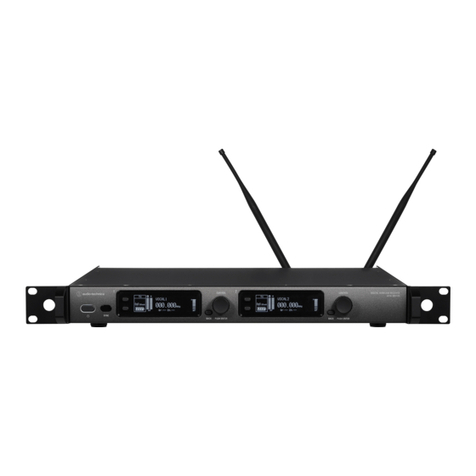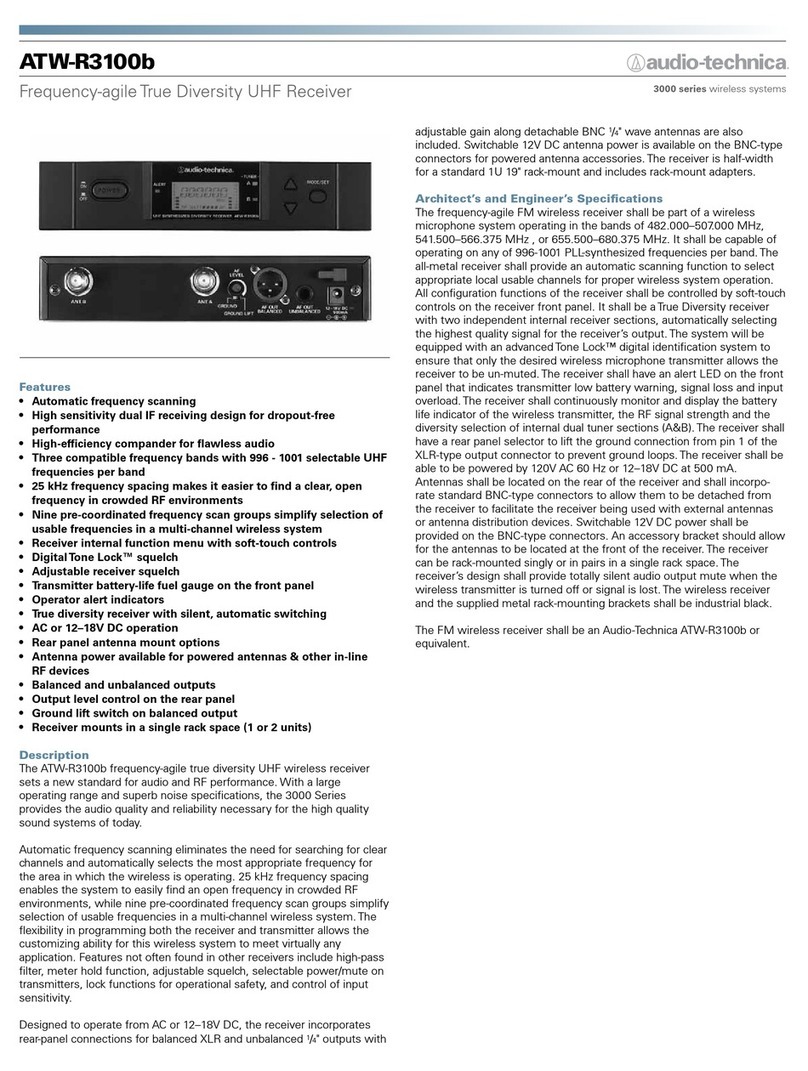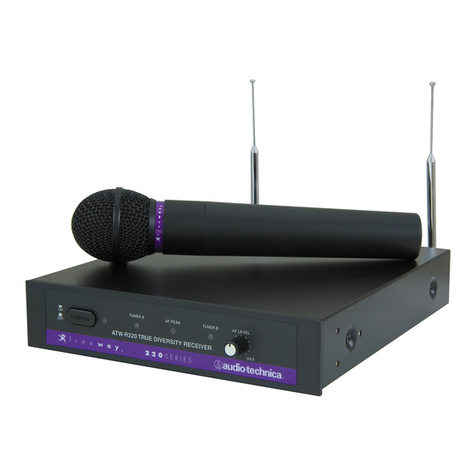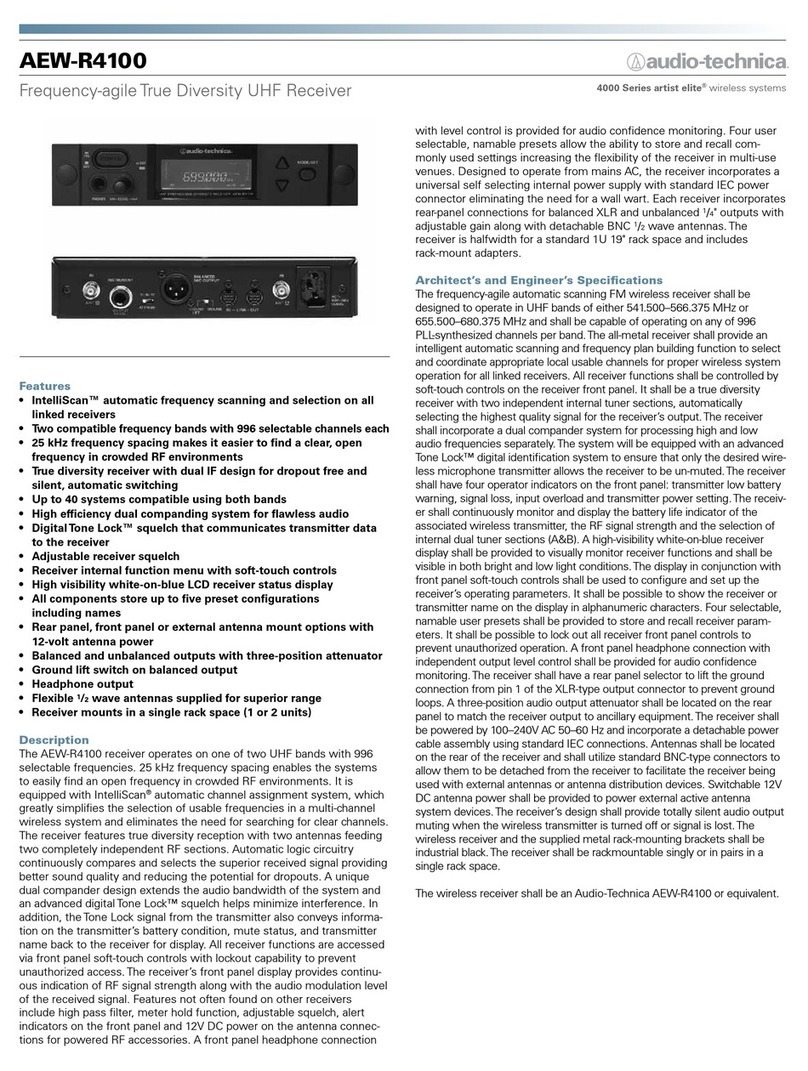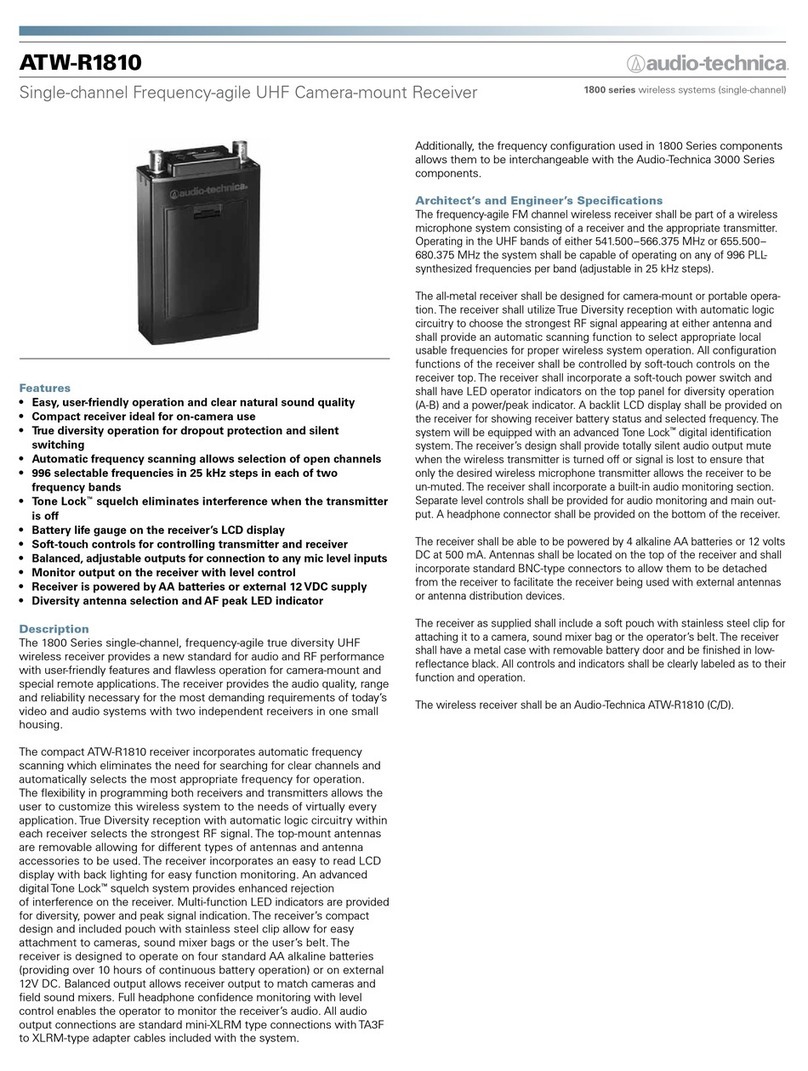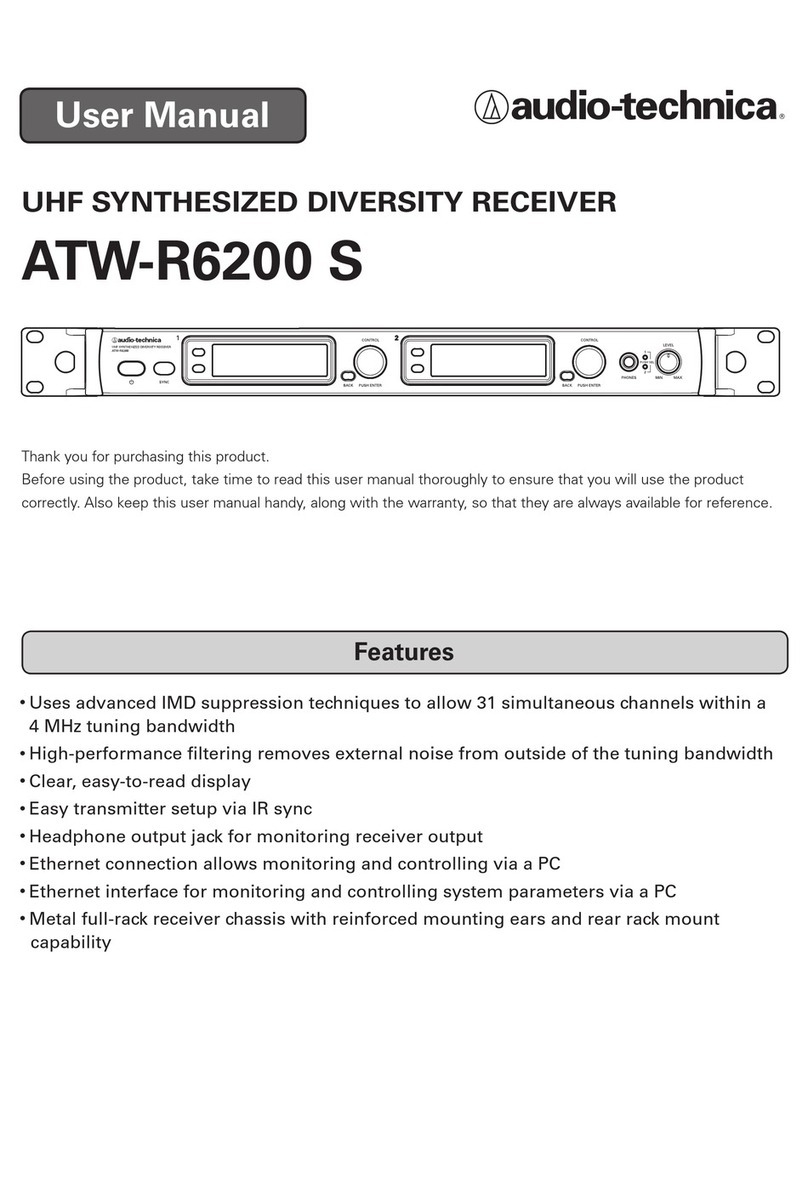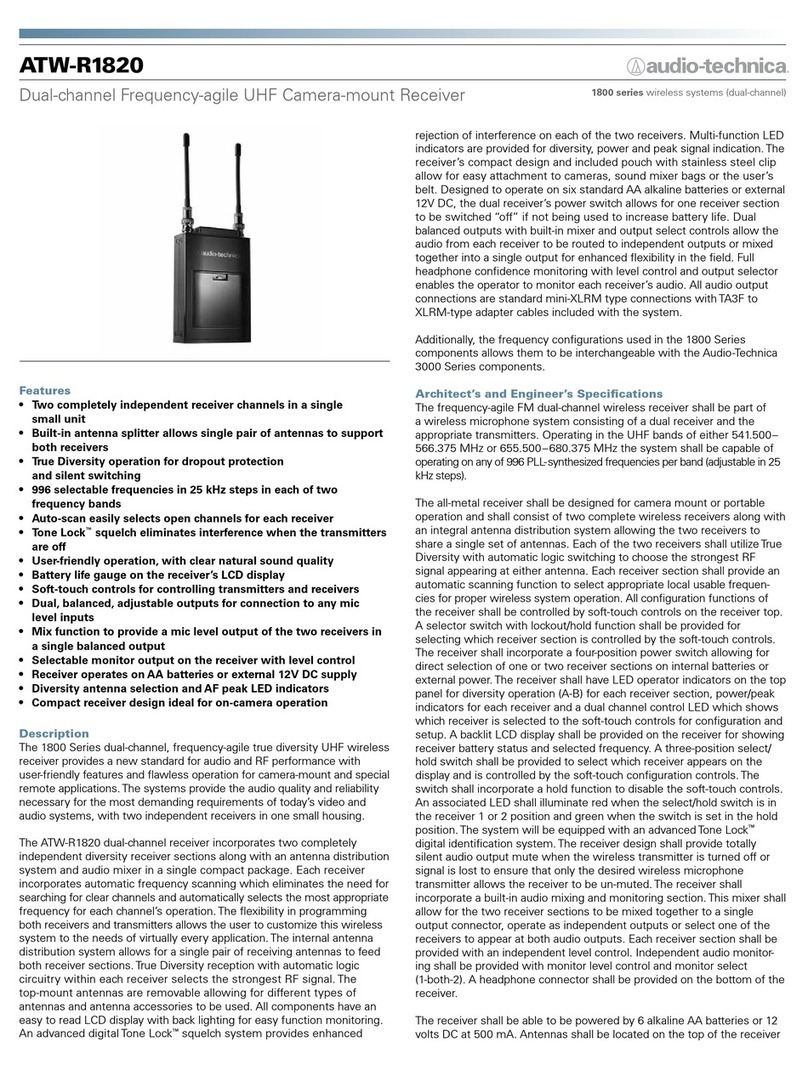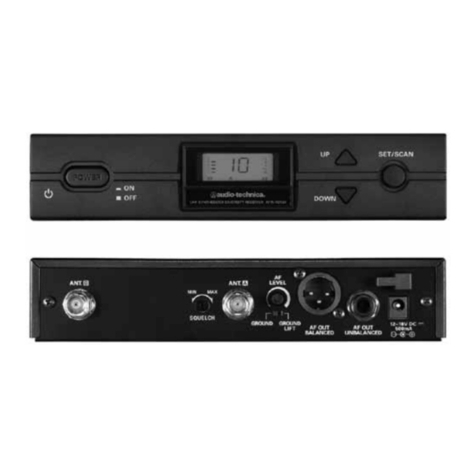
Location
For best operation the receiver should be at least 1 m.
above the ground and at least 1 m. away from a wall or
metal surface to minimize
reflections. The transmitter
should be at least 1 m. from
the receiver, as shown in
Figure A.
Keep antennas away from
noise sources such as digital
equipment, motors,
automobiles and neon
lights, as well as large
metal objects.
2
ATW-R92 UHF Synthesized Diversity Dual Receiver
Installation and Operation
CAUTION! The circuits inside the receiver and transmitter
have been precisely adjusted for optimum performance and
compliance with federal regulations. Do not attempt to open
the receiver or transmitter. To do so will void the warranty, and
may cause improper operation.
Individuals with implanted cardiac pacemakers or AICD
devices:Please see notice on back cover.
This device complies with part 15 of the FCC Rules. Operation
is subject to the condition that this device does not cause
harmful interference.
This device complies with INDUSTRY CANADA R.S.S. 210, en
conformit avec IC: RSS-210/CNR210. Operation is subject to
the following conditions: 1) This device may not cause harmful
interference and 2) this device must accept any interference
received, including interference which may cause undesired
operation.
Introduction
Audio-Technica Engineered Sound¨wireless systems are
offered as separate receiver and transmitter units, rather
than in predetermined combinations, for greatest system
flexibility. Operating details for Engineered Sound transmit-
ters are included with each transmitter.
Engineered Sound receivers feature a sophisticated Tone
Lockªtone squelch system that opens only when an
Engineered Sound transmitter is detected, reducing the
possibility of interference. As a result, Engineered Sound
transmitters and receivers must be used together and
should not be used with components from other
Audio-Technica wireless systems, or with those of other
manufacturers.
The ATW-R92 Dual Receiver unit features two independent
receivers in its housing, along with an antenna combiner/
divider system. Each receiver offers 100 PLL-synthesized
UHF frequencies and true diversity reception. In each
receiver, two antennas feed two completely independent
RF sections (Tuners) on the same frequency. Automatic
logic circuitry continuously compares and selects the superi-
or received signal, providing better sound quality and
reducing the possibility of interference and dropouts. The
ATW-R92 is housed in a full-width standard 19" (1U)
rack-mountable case, with rack-mount adapters included.
The antenna combiner/divider system in the ATW-R92
provides two "A" and two "B" antenna inputs that feed
each of the two diversity tuners in each receiver. As one
example, the two pairs of inputs might be used when
coverage of a split banquet/meeting room is difficult with
a single pair of antennas, or when considerable multipath
interference is present. Two "A" and two "B" antenna
output
jacks are provided to feed other wireless receivers
operating in the same frequency band. With the addition of
two more ATW-R92 dual receiver units, up to six receiver
channels can be operated from a single pair of antennas.
However, any type of receiver in the same band, or even a
separate active antenna divider, may be fed by the antenna
outputs. The ATW-R92 also provides +12V DC on the
antenna input jacks to power in-line RF devices.
Please note that in multiple-system applications there must
be a transmitter-receiver pair set to a separate frequency for
each input desired (only one transmitter at a time for each
receiver). Because the wireless frequencies are on UHF TV
frequencies, only certain wireless frequencies may be use-
able in a particular geographic area. Also, only certain of the
available operating frequencies may be used together in
multi-channel systems. (Suggestions for multiple-frequency
groupings will be found on page 7.)
AVIS
RISQUE DE CHOC ELECTRIQUE
NE PAS OUVRIR
CAUTION
RISK OF ELECTRIC SHOCK
DO NOT OPEN
Warning: This apparatus must be grounded.
This product is a safety class 1 product.
There must be an uninterruptible safety earth
ground from the main power source to the
product's AC input. Whenever it is likely that
the protection has been impaired, disconnect
the power cord until the ground has been
restored.
Attention: Cet appareil doit etre mise a la
terre. Cet appareil est de classe de surete 1.
Il doit y avoir un ininterrompable de mise a la
terre de securite provenant de la source
principale de courant de l'appareil de l'entree
du courant alternatif. Quand la protection a ete
affaiblie, d brancher le fil de courant jusqu'a la
mise a terre a bien ete reetablie.
Warning: To prevent fire or shock hazard, do
not expose this appliance to rain or moisture.
Attention: Pour prevenir feu ou choc
electrique, ne pas expose l'appareil a la pluie
ou a l'humidite.
Caution/Avis: For continued protection
against fire hazard, replace only with same
type/rating of fuse.
Pour poursuivre la protection contre le feu,
replacez la fusible de meme type/cote.
Warning/Attention: There are some sharp
edges inside. To reduce the risk of injury,
do not remove cover.
Bord tranchant a l'interieur. Pour reduire le
risque de blessure, ne pas ouvir le couvercle.
To prevent electric shock, do not remove the
cover. There are no user-serviceable parts
inside. Internal adjustments are for qualified
professionals only. Refer all servicing to
qualified service personnel.
Pour prevenir un choc electrique, ne pas ouvrir
le couvercle. Il n'y aucune pieces de rechanges
a l'interieur. Tout ajustement interne doit etre
fait par une personne qualifi seulement.
Referez tout reparation au personnel qualifie.
Receiver Installation
Fig. A
1m
1m
1m 1m
